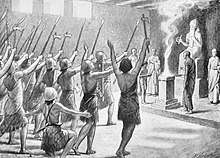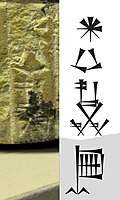Utu-hengal
Utu-hengal (Sumerian: 𒀭𒌓𒃶𒅅, Dutu-ḫe₂-ŋal₂), also written Utu-heg̃al, Utu-heĝal, and sometimes transcribed as Utu-hegal, Utu-hejal, Utu-Khengal, was one of the first native kings of Sumer after centuries of Akkadian and Gutian rule, and was at the origin of the foundation of the Third Dynasty of Ur by his son-in-law Ur-Nammu. He was officially "King of Uruk" in his inscriptions, and is therefore consider as the founder, and only member, of the "Fifth dynasty of Uruk" (Uruk V).[1][2]
| Utu-hengal | |
|---|---|
| King of Uruk | |
 | |
| Reign | c. 2055 BC – 2048 BC |
| Predecessor | Tirigan (Gutian Dynasty) Nam-mahani (Second Dynasty of Lagash) |
| Successor | Ur-Nammu |
| Dynasty | 5th Dynasty of Uruk |
Life and reign
There are several theories regarding his background. The most common is that he was a governor of Uruk who revolted against the Gutian kings in c. 2050 BC. He led the cities of Sumer against the last Gutian king Tirigan. After a battle at an unknown location, Utu-Hengal was victorious and forced Tirigan to flee back towards Gutium.[3] Tirigan fled to the city of Dubrum (location unknown) where the people treated him kindly. However, once the people of Dubrum heard that Utu-Hengal was marching towards the city they took Tirigan and his family prisoner. He was brought before Utu-Hengal, and agreed to leave Sumer and retreat back to Gutium.[4]
After defeating the Gutians, Utu-hengal established himself as the king of Sumer. In the seventh year of the kingship he tragically died in an accident when inspecting a dam (leading some to suspect foul play),[7] and was succeeded by his son-in-law, the governor of Ur, Ur-Nammu, as the king of Sumer. He was thus the only king of the fifth dynasty of Uruk. In fact Sumerian people have always treated Utu-hengal's kingship and the Ur III dynasty together as a single continuous dynasty, with Utu-hengal as the founder. Utu-hengal has been praised as one of the greatest historical figures and heroes of Sumerian people.
Family
Utu-hengal had a daughter who married Ur-Nammu and gave birth to his successor, Shulgi, and was therefore related by marriage to the third dynasty of Ur. He was an ancestor of Amar-Sin.
Inscriptions
Utu-hengal is known through numerous inscriptions.[10]
Victory stele
.jpg)
A victory stele was erected in Uruk by Utu-Hengal, a copy of which was made during the Dynasty of Isin, now in the Louvre Museum (AO 6018).[12] The stele described the victory of Utu-Hengal over the Gutians, particularly their king Tirigan. The beginning of the inscription reads:
"Enlil! Gutium, the fanged snake of the mountain ranges, a people who acted violently against the gods, people who the kingship of Sumer to the mountains took away, who Sumer with wickedness filled, who from one with a wife his wife took away from him, who from one with a child his child took away from him, who wickedness and violence produced within the country— Enlil, the king of all the lands, to obliterate its name, Utuḫegal, the mighty man, the king of Uruk, the king of the four world quarters, the king whose utterances cannot be countermanded, Enlil, the king of all the lands, issued to him a command about this. To Inanna his lady he went and prayed to her, (saying) “My lady, lioness of battle, who the foreign lands batters, Enlil, the kingship of Sumer to return to its own control he commanded me. May you be my ally.” An army of many foreigners bore down upon the land everywhere. Tirigan, the king of Gutium, opened its (canal?) mouths, but no one came out against him. Both banks of the Tigris he had seized. To the south, in Sumer, the cultivated land he tied up, to the north, the roads he tied up. On the highways of the country he made tall grasses grow (....)
By the envoys of Utuḫegal Tirigan and his wife and children in Dabrum were captured. They placed fetters on his handsand put a cloth (blindfold) over his eyes. Utuḫegal before Utu made him lie at his (Utu’s) feet, and on his neck he set his foot. Gutium, the fanged snake of the mountain ranges, he made drink from the cracks in the earth."
Copper-alloy vase

.jpg)
Dutu-he2-gal2 / nita kal-ga / lugal unuki-ga / lugal an-ub-da limmu5-ba
"Utu-hengal, the great man, King of Uruk, King of the four quarters of the world"
A copper-alloy vase, now in the British Museum (BM 1999,0731.1), has an inscription by Utu-hengal:[15]
[This is] Utu-hegal, Powerful male, King of Uruk, King of the four quarters, Whoever Erases the inscription And writes his own name instead Or who, on account of this curse, Has someone else take hold of it And remove it, may his reign Be cut short! May his progeny be wiped out! May An, king of the gods, And Inanna, lady of Uruk, ... curse him!
— Utu-hengal copper-alloy vase inscription.[16]
Stone fragment
Another fragmentary inscription of Utu-hengal, also in the British Museum, only mentions his name and titulature: "Utu-hengal, the great man, King of Uruk, King of the four quarters of the world".[17]
 Part of a stone monument inscribed with the name of "Utu-hengal, the great man, King of Uruk, King of the four quarters of the world". Circa 2125 BCE. From Ur, Iraq. The British Museum, London.[18]
Part of a stone monument inscribed with the name of "Utu-hengal, the great man, King of Uruk, King of the four quarters of the world". Circa 2125 BCE. From Ur, Iraq. The British Museum, London.[18] "Utu-Hen(gal)" in cuneiform
"Utu-Hen(gal)" in cuneiform Utu-hengal inscription. "Utu-hengal, the great man, King of Uruk, King of the four quarters of the world".[19]
Utu-hengal inscription. "Utu-hengal, the great man, King of Uruk, King of the four quarters of the world".[19]
References
- "Utu-hengal, king of Uruk" in Basmachi, Faraj (1975). Treasures of the Iraq Museum. Al-Jumhuriya Press. p. 29.
- George, A. R. (2003). The Babylonian Gilgamesh Epic: Introduction, Critical Edition and Cuneiform Texts. Oxford University Press. p. 109. ISBN 978-0-19-927841-1.
- Samuel Noah Kramer (2010-09-17). The Sumerians: Their History, Culture, and Character. University of Chicago Press. ISBN 978-0-226-45238-8., p. 37
- As described in the document translated by Kramer, The Summerians, pp. 325f
- "CDLI-Found Texts". cdli.ucla.edu.
- THUREAU-DANGIN, Fr. (1912). "La Fin de la Domination Gutienne". Revue d'Assyriologie et d'archéologie orientale. 9 (3): 111–120. ISSN 0373-6032. JSTOR 23283609.
- Cooper, Paul M. M. "The Sumerians - Fall of the First Cities".
- "CDLI-Found Texts". cdli.ucla.edu.
- THUREAU-DANGIN, Fr. (1912). "La Fin de la Domination Gutienne". Revue d'Assyriologie et d'archéologie orientale. 9 (3): 111–120. ISSN 0373-6032. JSTOR 23283609.
- "CDLI-Found Texts". cdli.ucla.edu.
- Full transcription and translation in: "CDLI-Found Texts". cdli.ucla.edu.
- "Louvre Museum Official Website". cartelen.louvre.fr.
- Full transcription and translation in: "CDLI-Found Texts". cdli.ucla.edu.
- THUREAU-DANGIN, Fr. (1912). "La Fin de la Domination Gutienne". Revue d'Assyriologie et d'archéologie orientale. 9 (3): 111–120. ISSN 0373-6032. JSTOR 23283609.
- "Vase". British Museum.
- "Vase". British Museum.
- Full transcription: "CDLI-Archival View". cdli.ucla.edu.
- Full transcription: "CDLI-Archival View". cdli.ucla.edu.
- Full transcription: "CDLI-Archival View". cdli.ucla.edu.
| Regnal titles | ||
|---|---|---|
| Preceded by Tirigan (Gutian dynasty) |
King of Ur, Sumer and Akkad ca. 21st century BCE |
Succeeded by Ur-Nammu (Third dynasty of Ur) |
.jpg)